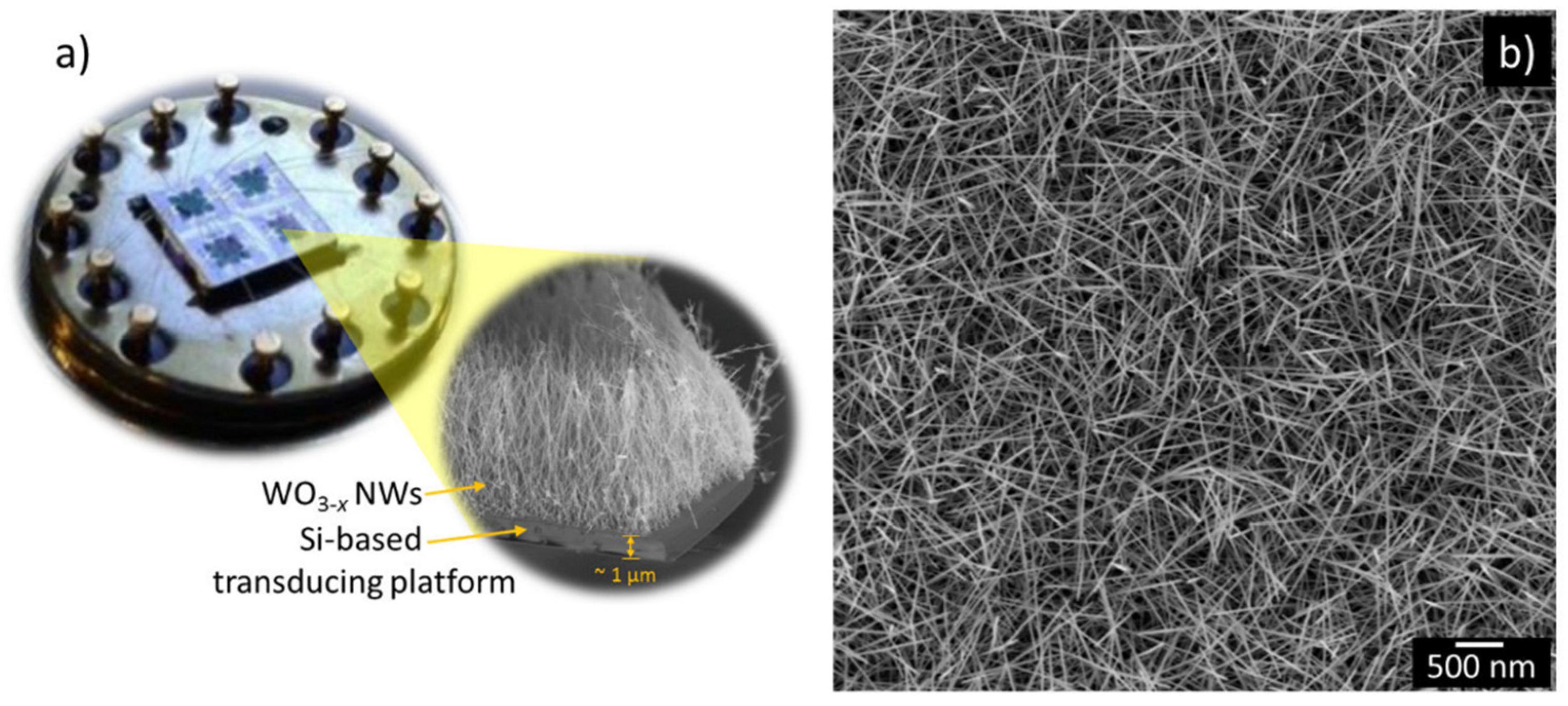Room Temperature Ethanol Microsensors Based on Silanized Tungsten Oxide Nanowires †
Abstract
:1. Introduction
2. Materials and Methods
3. Results
4. Conclusions
Author Contributions
Acknowledgments
Conflicts of Interest
References
- Vallejos, S.; Umek, P.; Blackman, C. AACVD Control parameters for selective deposition of tungsten oxide nanostrucutres. J. Nanosci. Nanotechnol. 2011, 11, 8214–8220. [Google Scholar] [CrossRef] [PubMed]
- Vallejos, S.; Grácia, I.; Chmela, O.; Figueras, E.; Hubálek, J.; Cané, C. Chemoresistive micromachined gas sensors based on functionalized metal oxide nanowires: Performance and reliability. Sens. Actuator B 2016, 235, 525–534. [Google Scholar] [CrossRef]
- Prades, J.D.; Jimenez-Diaz, R.; Hernandez-Ramirez, F.; Barth, S.; Cirera, A.; Romano-Rodriguez, A.; Mathur, S.; Morante, J.R. Equivalence between thermal and room temperature UV light-modulated responses of gas sensors based on individual SnO2 nanowires. Sens. Actuator B 2009, 140, 337–341. [Google Scholar] [CrossRef]
- Wang, B.; Haick, H. Effect of Functional Groups on the Sensing Properties of Silicon Nanowires toward Volatile Compounds. ACS Appl. Mater. Interfaces 2013, 5, 2289–2299. [Google Scholar] [CrossRef] [PubMed]
- Reichardt, C.; Welton, T. Solvents and Solvent Effects in Organic Chemistry: Third, Updated and Enlarged Edition; John Wiley & Sons, Inc.: Hoboken, NJ, USA, 2003. [Google Scholar]



Publisher’s Note: MDPI stays neutral with regard to jurisdictional claims in published maps and institutional affiliations. |
© 2018 by the authors. Licensee MDPI, Basel, Switzerland. This article is an open access article distributed under the terms and conditions of the Creative Commons Attribution (CC BY) license (https://creativecommons.org/licenses/by/4.0/).
Share and Cite
Vallejos, S.; Fohlerová, Z.; Tomić, M.; Gràcia, I.; Figueras, E.; Cané, C. Room Temperature Ethanol Microsensors Based on Silanized Tungsten Oxide Nanowires. Proceedings 2018, 2, 790. https://doi.org/10.3390/proceedings2130790
Vallejos S, Fohlerová Z, Tomić M, Gràcia I, Figueras E, Cané C. Room Temperature Ethanol Microsensors Based on Silanized Tungsten Oxide Nanowires. Proceedings. 2018; 2(13):790. https://doi.org/10.3390/proceedings2130790
Chicago/Turabian StyleVallejos, Stella, Zdenka Fohlerová, Milena Tomić, Isabel Gràcia, Eduard Figueras, and Carles Cané. 2018. "Room Temperature Ethanol Microsensors Based on Silanized Tungsten Oxide Nanowires" Proceedings 2, no. 13: 790. https://doi.org/10.3390/proceedings2130790
APA StyleVallejos, S., Fohlerová, Z., Tomić, M., Gràcia, I., Figueras, E., & Cané, C. (2018). Room Temperature Ethanol Microsensors Based on Silanized Tungsten Oxide Nanowires. Proceedings, 2(13), 790. https://doi.org/10.3390/proceedings2130790





